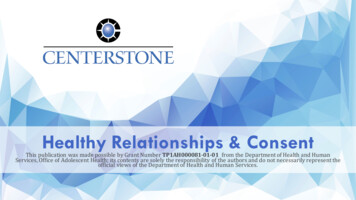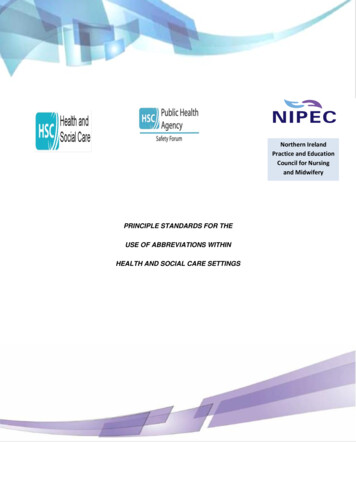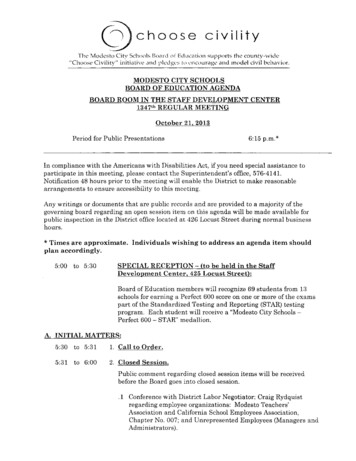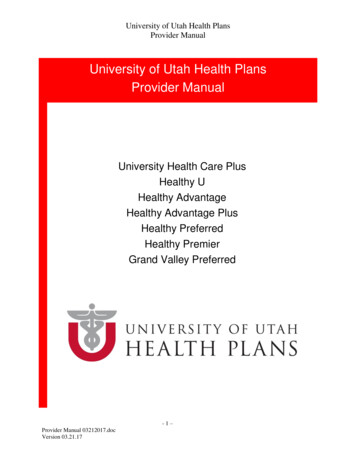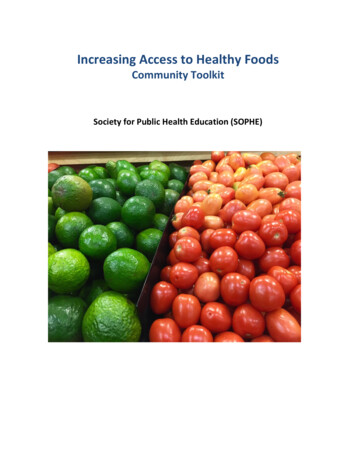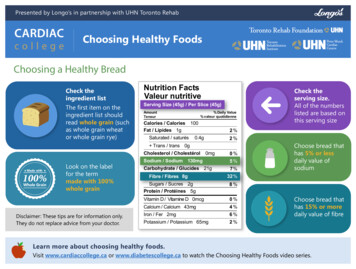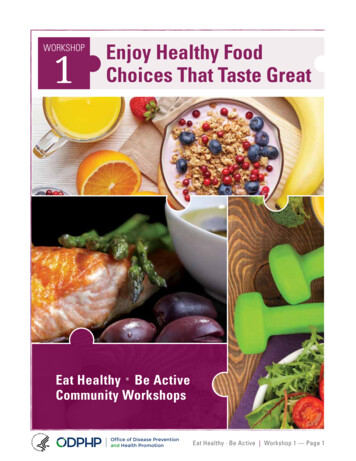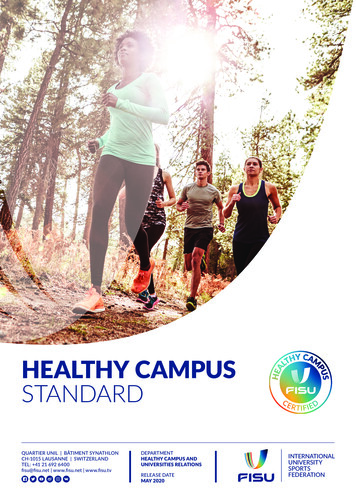
Transcription
Teaching about consent and healthyboundaries – a guide for educatorsIntroductionIPPF is committed to enabling young people to access comprehensivesexuality education (CSE) and to realize their sexual rights. For sexualityeducation to be truly ‘comprehensive’ we need to engage young peoplewith the wide range of issues which may relate to their lives – relationships,gender, decision making, and a number of other concerns they may haveabout their sexual and reproductive health now, and in the future. Whilstthis guide provides references to resources which can support a generalprogramme of sexuality education, the focus here is on the topic of consentand healthy boundaries. All young people need to know the importance ofbuilding healthy relationships and respecting the rights of others – and thisshould not be a one off lesson, but should be something which is woventhroughout an education programme, and which we model in our daily lives.“We need to go much further than just teaching “No means no” and “Yes meansyes”. Young people I work with know the definition of consent, but too oftenthey have very little idea about what consent looks, feels and sounds onships-educationWhy consent and healthy boundaries?IPPF’s Framework for CSE gives an overview of the importance of providingrights-based education on a range of issues, including: ‘sexual rights andconsent and the right to have sex only when you are ready’. Information onhealthy relationships and boundaries is crucial for children and young peopleof all ages – not just to help recognise and prevent abuse, but to strive forpositive and pleasurable experiences.We know that sexual harassment and sexual violence are commonoccurrences all over the world and can have a serious impact on health andwellbeing: It is estimated that about one in three women worldwideexperiences physical or sexual violence.Worldwide, up to 50% of sexual assaults are committed againstgirls under 16 years old.30% of women report that their first sexual experience was forced.An estimated 246 million girls and boys experience school-relatedviolence every year. Women who have been physically or sexually abused by theirpartners are more than twice as likely to have an abortion, almosttwice as likely to experience depression, and in some regions, 1.5times more likely to acquire HIV.Education about consent is essential for building healthy and respectfulrelationships, good sexual health and protecting potentially vulnerable peoplefrom harm. Teaching young people to acknowledge and respect other people’spersonal boundaries can help create a society where no one feels ashamedto willingly engage in, or to reject, sexual activity. Good quality education onconsent should strive to support young people to have safe, pleasurable andsatisfying experiences.If young people are only taught how to say ‘no’ to sexual experiences they areunlikely to understand the nuances of consent and communication when theydo become sexually active, and they are unlikely to have the sexual literacy orconfidence to seek experiences which are pleasurable and desirable.
Shouldn’t this only be taught to older groups?This guide provides sample session plans for children aged 8-12 years oldand for those aged 13-18 years old. A topic like consent should be exploredin the context of learning about healthy relationships and should not besolely limited to consenting to sexual activity. All children and young peoplehave a right to learn about bodily autonomy, their rights, and how to respectthe rights of others. General concepts such as trust, respect, safety andcommunication can be adapted for a younger audience, and more concretelytied to an understanding of sexual consent for older students. Those who havelearned about consent and boundaries will be better able to recognise abuseand to protect themselves and others from abuse and unhealthy relationshipsas they get older.Of course, the session plans provided are examples, which may need tobe adapted for local context, or the ages and abilities of the young peopleinvolved.Working with young people who have special educational needs“Some students with special education needs may have difficulty with abstract thinking,including thinking about the consequences of their behaviour, and may have troubleunderstanding the boundaries between private and public with respect to behaviour ortheir own bodies. When teaching students with special education needs about sexualhealth, it is important to teach the information in a variety of ways and to provide ampleopportunity for information to be repeated and for skills such as refusal skills to bepractised and lum/elementary/health1to8.pdfImage in Action has produced a ‘Sex and Relationships Education Course for learners withadditional needs’ which contains activities about relationships and consenthttp://www.imageinaction.org/pdf/GF SREcourse-6.12.10-1.pdfKey things to consider when working with any age group Carry out a needs assessment before embarking on a CSEprogramme and assess young people’s existing knowledge andunderstanding of consent issues so that lessons can be tailored tothem.Try to involve young people as much as possible in the planningand evaluation of your sessions.Ensure that sessions cohere with relevant policies and proceduresfor the environment you are working in and that you have supportand buy-in from parents/education authorities/community leadersas appropriate.Create as safe a space as possible by creating shared ‘groundrules’ and by providing information about support and localservices before and after the session. Consider cultural/faith dimensions to the activities/resourcesyou are using – are they inclusive and appropriate for all youngpeople?Are sessions interactive and do they employ learning methodswhich suit your group – consider any learning or physicaldisabilities and how activities can be adapted.Perhaps link your work on consent to national or internationalevents (such as the International Day for the Elimination ofViolence against Women), or even to current stories in the news/soap opera storylines to ensure that they are relevant and timely.
Working with 8 – 12 year oldsFrom an early age children will have questions about bodies and relationships,and it’s common for parents to talk to their children about how to respectothers, and which activities are best kept private. Education sessions inschools, and other settings should build on this to ensure children have a clearunderstanding of appropriate touch and know how to talk to someone theytrust.Things to think about: Be clear on the policies regarding child protection andsafeguarding where you are working. These kinds of discussionsmay lead to children disclosing abuse and all those involved will need to know the laws and policies in this area, as well as referralprocesses.Language, especially around body parts should be clear andaccurate. Make sure that children know the correct terms forgenitalia, and show diagrams if necessary.Be inclusive when discussing relationships, for example, notassuming all students live with a mother and father.Ensure students also have an opportunity to learn about relatedissues such as gender (what is expected of boys and girls), thebody and changes during puberty, different types of relationshipand so on.Session plan – My private spaceOVERVIEW: Students learn about physical boundaries and examine how the ‘rules’ apply to different people in their lives.OBJECTIVES: To help students identify appropriate boundaries for touch and their personal space including consent.DURATION: Approximately 1 hourTO PREPARE: Draw a large circle on a piece of paper (or use a hula hoop or rope tied into a circle) on the floor.INSTRUCTIONS1.Introduce the activity with the following explanation: Everyone’s body is special and is their own. It is up to you to decide who can touch youand how.2.Ask two students to stand inside the circle together and ask them how it feels to be so close [Perhaps nervous/anxious, excited, etc]. Explainto the whole group that they should imagine that this circle around themselves is their private space, and they get to decide who comes insidewith them.3.On a sheet of paper draw a circle to represent this ‘private space’ and then draw three more rings around it. Show the group a list/pictures ofdifferent people [for example, parent, best friend, aunty, teacher, stranger, police officer, religious leader etc] and ask them to say which circlethey think they should go in. When you’ve written the people into the circles, discuss the different types of contact that might happen with eachone [for example, a parent might kiss and hug, a best friend might give a high-five, a religious leader might just nod]. Answer any questionsstudents might have about the types of touch which are appropriate from different people they know/encounter.4.Follow up with a second activity which breaks down where on the body people can touch – split students into groups of three or four.5.Give each small group a large piece of paper and ask them to draw the outline of a person.6.Explain that there will be times when you might let someone into your ‘private space’ but that there are still ‘rules’ around who is allowed in,and if and how they might touch you.7.Write up different scenarios or give them out on cards [for example: visiting the doctor, meeting a new classmate, playing with your brother,learning to swim, hugging your mum.] and ask students to take it in turns to read out the scenario. The group should mark on their outlinewhere they think it would be OK to be touched in each scenario, and to explain what type of touch might be allowed.8.Bring all groups back together and discuss the activity, drawing out the fact that the rules will be different depending on who the person is.KEY MESSAGES Whoever the person is you have a right to say if they are making you uncomfortable – if they are too close to you or touch youin a way you don’t like.Your body is your own and people shouldn’t break the rules – if they do you should talk to an adult you trust.We should be aware of what other people like and dislike and try not to do things which might upset them or make themfeel uncomfortable.
Working with 13 – 18 year oldsOlder adolescents should have an opportunity to discuss a wide range ofrelationships (including romantic and sexual ones) and may themselves bestarting to become sexually active. Therefore lessons about consent andboundaries should acknowledge the importance of consent when it comes tosexual activities. Of course, education on this subject needs to be supportedby learning about gender roles, communication in relationships, sex andthe law and so on. It’s All One Curriculum provides further activities andinformation for this.Things to think about: Make sure you have an understanding of relevant laws andpolicies regarding young people, the age of consent to sex,pornography and so on. Students should be clear on what rightsand responsibilities they have under the law, but also in particularcontexts (for example, what will happen if they disclose sexualactivity to a teacher, a nurse and so on). Be aware that such sessions may lead to requests for furtherinformation and support, or even disclosure of abuse. Be sure toprovide information on relevant services and to be clear on yourown role with regards to referral and support.Young people need to feel safe during the session – groundrulescan help with this but they should also be informed that theydo not have to join in with activities which make them feeluncomfortable.Remember to keep the session inclusive and do not makeassumptions or judgements about whether students are or aren’tsexually active. Ensure that discussions and case studies do onlyfeature heterosexual relationships.Be careful not to only define ‘sex’ as ‘penis in vagina’ sex orintercourse – ensure discussion of sexual consent acknowledgesdifferent activities and is couched within respect for people’s bodilyautonomy more generally.Lesson plan : The matter of consent(using case studies from It’s All One Curriculum: Guidelines and Activities for a Unified Approach to Sexuality, Gender, HIV, and Human RightsEducation) http://www.popcouncil.org/uploads/pdfs/2011PGY ItsAllOneActivities en.pdfOVERVIEW: Students learn about the concept of sexual consent. They explore this concept in case studies, role play, and discussion.OBJECTIVES: To help students understand and appreciate the importance of consent in any sexual situation; to strengthen abstract thinking skills.DURATION: Approximately one hourTO PREPARE: Familiarise yourself with It’s All One Curriculum. Select case studies from pages 79-80 of the Activities book that reflect commonsituations in your setting and adapt them by changing names or other details. Or, develop alternative case studies. Use some case studies in which thecharacters are able to give free and informed consent and some in which they are not. Write the guidelines on the board ahead of time. Find out aboutthe law in your country regarding the age of consent for sexual activity.INSTRUCTIONSPart 1: Introducing consentAfter agreeing ground-rules for the session, start by asking young people to sit in a circle and to throw a ball to each other. As each person catchesthe ball they should answer the question: “What are the ingredients for a good relationship?” (be clear here that you are talking specifically about aromantic relationship.) If time allows, each person should give their word or short phrase.You will likely get words which refer to ‘respect’ ‘good communication’ ‘fun’ and so on. Discuss any themes which have emerged, or any meaningswhich were not clear. Explain that in this session the group will be discussing consent in relationships, and that actually, a lot of the things which makefor a positive or healthy relationship are also the things we need for good sex. Having any kind of sex with another person requires communication,mutual respect (and desire!) and this is what consent is all about.Ask students to offer definitions of ‘consent’ in general. (This could start with students writing down definitions anonymously, or discussing in pairs).This doesn’t need to be just referring to sexual consent, but the group should come to some sort of definition about ‘agreeing to something’, ‘beingwilling to do it’.If there is time, include further information about laws and policies in the country you areworking in regarding sexual consent. For example, the legal age of sexual consent (which differsin some places depending on gender or whether there is opposite or same sex activity), lawsaround viewing or producing pornographic images (particularly relevant for young people whomay be sharing images online) and how the law protects young people from harm – their rightsto access services and information.
Then explain that sometimes, when it comes to sex, people talk about ‘free and informed consent’. What could some obstacles be to someone giving‘free and informed consent’ to sexual activity? You could write students’ answers down on a board/piece of paper (some possible examples below):They don’t want to do it! // They don’t understand what they are agreeing to // they don’t have enough information about sex or risks involved //They feel pressurized to say yes to sex // They are affected by alcohol or drugs and can’t think properly // There is a power imbalance, for example theirpartner is much older than them.If there is time, include further information about laws and policies in the country you are working in regarding sexual consent. For example, the legalage of sexual consent (which differs in some places depending on gender or whether there is opposite or same sex activity), laws around viewing orproducing pornographic images (particularly relevant for young people who may be sharing images online) and how the law protects young peoplefrom harm – their rights to access services and information.Part 2: Understanding consentAsk a student to read aloud the ‘guidelines for meaningful consent’ and consider displaying or giving to students as a hand-out.Get students into small groups and provide each group with a case study from page 79 and 80 of the It’s All One Curriculum resource. (Three examples– with responses for educators – are provided in this guide for ease of access). You may need to make changes to the scenarios based on local contextor age of consent laws in your country.Ask small groups to discuss the case study and if they think the guidelines for meaningful consent are met.Each small group should: Read their case study to the whole groupAct out a brief role play of their case studyShare their views on whether they think the guidelines were met and whyOpen the discussion out to the whole group to ensure there is understanding of when consent is and isn’t possible. Ask students if a person canknow for certain if a partner is consenting without talking with that person? Why or why not? What can someone do to be sure that a person who is“consenting” to sex is doing so freely and in an informed way?Finish the discussion by stating that we know that circumstances exist in which a person does not have the control or power to say no. This is aviolation of human rights.KEY MESSAGES All people have the right to give or withhold sexual consent. All people have the responsibility to respect their partners’ right to give orwithhold such consent.As young people mature, their capacity to give meaningful consent evolves.At any moment, you are entitled to change your mind about what feels acceptable or to speak up if you believe you are not being fullyunderstood and respected. You can say no to a sexual experience even after it has started.SELECTED CASE STUDIESJin is 20 and Josef is 19. About six months ago, Jin asked Josef, her boyfriend, if he would have sex with her. They are open and honest with eachother, so he told her he was afraid of the consequences and did not feel ready. He said he would like just to kiss and touch each other for now. Jinreally wanted to try intercourse, but she agreed with Josef. Now Josef thinks he is ready. He asks Jin where they can get more information to avoid anyrisk. Can Josef give free and informed consent?Yes – Josef believes he has the right to decide for himself; he is able to communicate and implement his decision, and his partner respects it; his mindis clear; he does not have an overriding economic or material motive; he is aware of and intends to inform himself about risks and protection; and he islegally old enough to make the decision. Although we don’t know if the partners have discussed their previous sexual behavior or drug use, we knowthat they are open and honest with each other.Eve is 14 and in school. Edo is 18 and works with Eve’s father. Edo came to know Eve when he visited her house. Edo and Eve have started meetingaway from her house as well. Sometimes Edo gives Eve presents and money, if she needs it. Recently he has started telling her how much he loves herand saying that he really wants to have sex with her. Can Eve give free and informed consent?No – The sexual consent of a 14-year-old is rarely meaningful, because of his or her still-developing maturity. Concerns about maturity and children’srights have led to the establishment of laws defining a minimum age for giving sexual consent and outlawing child marriage. (discuss law in your country)(discuss whether buying people things is coercive or not)Gia, 24, is at a party at the house of some students, and she is drinking a lot. Her partner, with whom she has had sex before, pulls her into abedroom and starts taking off her clothes. She is fading in and out of consciousness. Can Gia give free and informed consent?No – Gia is drunk and nearly unconscious. She is unable to decide for herself, and her partner is not communicating with her.
Guidelines for giving meaningful consent in a situation involving sex Believe that you have the right to decide for yourself whether or not you want to participate in a particular sexual activity.Have a sufficient sense of power and control over your own life to be able to communicate and implement your decision.Have the maturity to understand what an activity entails and what consequences it might bring, and the maturity to communicate withyour partner about these issues.Be in a situation or relationship where your decision will be recognized and respected by your partner.Know what the activity involves and what your feelings are about it; what the risks are; and how to protect yourself and your partner fromunwanted pregnancy and infection.Have a clear mind, not impaired by alcohol or drugs at the time of decision making.Have accurate information about your partner’s current sexual health status (including about any previous sexual exposure or drug use thatcould present a risk to you).As best you can, avoid situations where you are likely to experience pressure to have unwanted sex for material or financial reasons.This resource gives a great example of an active way to engage with the conceptof consent – using handshakes (pages 49-52). Note that in some contexts, religionor culture may affect the appropriateness of this activity for your idance-from-do.pdfWorking with parents and carersWhether your education sessions take place in a school, youth club or a less formal setting it is important that parents and guardians of youngpeople are informed and involved. You may have the ability to work directly with parents and carers and could consider delivering educationalworkshops directly to this group to ensure intergenerational understanding and dialogue. You may have concerned parents asking why a subject suchas consent is being addressed. This section of the guide provides some tips for talking to parents and carers: Ensure parents and carers understand the rationale for talking to children and young people about consent and healthy boundaries. It maybe useful to provide local statistics and information about sexual harassment and abuse, or even quotes from students on their concernsand confusion regarding the topic.Good quality sexuality education should involve young people in its design, delivery and evaluation. Ensure that parents and carers cansee that young people’s own needs and ideas have shaped the programme and that the content will be relevant and appropriate to theirage group.Explain that lessons for younger adolescents will not be about sexual consent but about safety and understanding personal space andboundaries – vital for recognising and reporting abuse. Articles such as this may prove useful: n/Talk with parents and carers about what the law says about sexual consent and young people – they may not know what rights andresponsibilities their children have when it comes to relationships, sexual activity, pornography consumption and sharing images.Encourage parents and carers to have a look at the information and activities from It’s All One Curriculum so that they are familiar withwhat will be shared with young people and how it links to other parts of their education.
girls under 16 years old. 30% of women report that their first sexual experience was forced. An estimated 246 million girls and boys experience school-related violence every year. Women who have been physically or sexually abused by their partners are more than twice as likely to have an abortion, almostFile Size: 904KB

